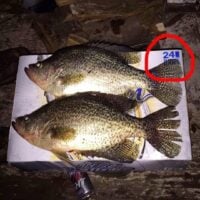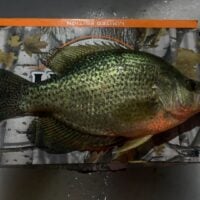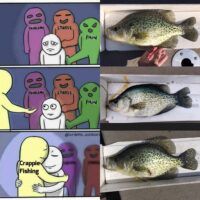I think BrianF has just hit on something a lot of people overlook. A water that will hold large crappies “consistently” almost always has to be large enough to support several different year classes of crappies that get spread out all through that system AND has to have a forage base that is diverse enough to support the diets of the differing classes[sizes] of crappies. The different year classes of crappies definitely have appetites that reflect their needs based on size. Lake Minnetonka is large enough and diverse enough to support large numbers of quite large fish. The key here is figuring those larger fish out. Minnetonka could easily have 50 loose schools of 15″ fish in it. Smaller bodies of water can have and hold very large crappies but usually their numbers won’t be high because the lake itself will not offer enough of what’s needed to support a large number of the larger crappies. Then too, genetics have to be present that makes a crappie capable of growing to a large size and those genetics do not exit in all waters.
It doesn’t take very long for a serious crappie angle to realize that those big fish, while they may be found in and around smaller fish, have very different needs food-wise and that often-times results in their being deeper, or shallower, or further to the outside where the smaller fish are being caught. As mentioned, big crappies love the seclusion that weeds offer and are often found buried in deep in weeds where they can ambush their prey. Seriously big crappies seldom allow smaller crappies to share the same small area where they are hunting for food and will push them out and away from that area. A 15″ crappie can and will feed on forage in the 3 to 4 inch range that includes sunfish and perch in that size range as well as shad and other soft-rayed forage even larger. Most crappie anglers fail to use baits or plastics that come remotely close to what these big fish will eat.
In short, big crappies start at about 13″ and they get more “unlike” smaller crappies as they grow larger so if one wants to catch truly large crappies they need to get past the idea that they’ll catch any numbers of the big ones if they find and fish smaller crappies. And that is food for thought for the summer as well as winter fishing. Big crappies are every bit as much a predator fish as their toothy buddies and their habits, food sources and preferred waters reflect exactly that.
Most of today’s average crappie anglers dream of the big fish but stay stuck on catching crappies that don’t clear the 12″ mark because they won’t change locations of tactics that address the truly large ones. Which is likely a good thing as these are likely anglers that keep what they catch. For table fare, those big suckers have passed their prime as table fish. A friend and I fish a lot and we target and keep crappies in the 11 to 12 inch range for the table unless we deep hook a bruiser and its bleeding from the gills. If we have to kill it, we keep it and that goes for smaller fish as well. We catch plenty of 14″ and 15″ fish but slip them back in the drink.
To the original poster: If you live inside the Cities you’re probably not more than 15 miles away from that 15″+ fish. You just need to focus on what will catch that animal because that 15″ crappie is in no fashion similar to the 9″ crappies that abound there in the metro. The Red Wing area, the Lake City area, the Wabasha and the Winona area all have waters that hold big crappies…. including that 15′ you so desire. If you’re thinking ice, think a very long walk and no other anglers.


